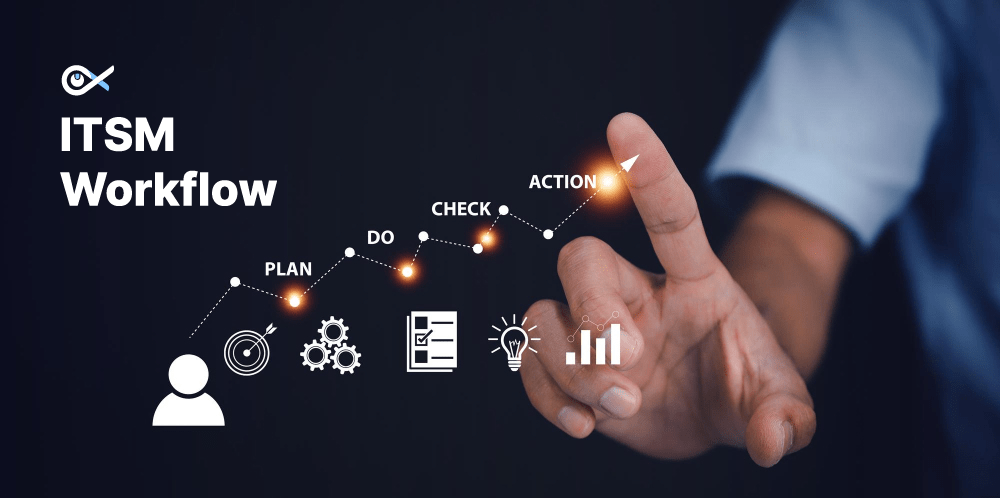In an era where businesses are driven by digital transformation, how organizations manage their IT services can be the line between operational efficiency and systemic breakdown. Central to this is the concept of IT Service Management (ITSM) and, more pointedly, the ITSM workflow. This blog aims to unravel the nuances, benefits, and modern approaches to ITSM workflows.
Related blog: A Complete Guide on Workflow Automation for 2022
Definition of an ITSM Workflow
The ITSM workflow is a meticulously designed structured sequence of tasks aimed at driving the efficacy and predictability of IT service delivery. As the ITSM methodology’s foundation, the workflow ensures that each ITSM operation, from incident reporting to service delivery, adheres to established benchmarks and standards.
What is an ITSM workflow? – How does it work?
Information Technology Service Management, often abbreviated as ITSM, has always been a subject of intrigue and curiosity for many, especially for those not directly involved in the IT world. The commonly posed question, “What is an ITSM process?” merits a comprehensive explanation. Think of it in the context of a bustling production factory. Here, a conveyor belt serves as a pathway. Items are placed at their beginning, and as they travel the belt’s length, they undergo various modifications or checks, finally emerging as polished, finished products.

In much the same vein, the ITSM process can be visualized as a meticulously structured workflow, a well-oiled machine comprising a series of interrelated processes, each tailored to address specific facets of ITSM operations. This workflow ensures the timely and effective management of IT services.
Initiation: Picture this as the ignition of machinery. It sets the entire process into motion. Here, an incident is flagged, or a service request is initiated, signaling the start of the workflow.
Classification: This step can be likened to a sorting mechanism in a factory. Every incoming issue or request is classified based on its nature and specifics. This systematic categorization helps direct the issue to the most suitable resolution path.
Prioritization: Imagine a triage system where matters are ranked based on urgency. In ITSM, not every incident or request is of the same magnitude. Therefore, critical or high-priority issues are addressed first, ensuring that core ITSM operations are not adversely affected.
Assignment: Think of this as appointing specialized factory workers to a task. Here, based on the nature and complexity of the issue, the most suitable team, armed with the necessary tools and expertise, is delegated the responsibility of resolution.
Execution: Now, the real work begins. The designated team embarks on the task of resolving the issue, leveraging the rich arsenal of best practices embedded in the ITSM methodology.
Review: Analogous to a quality check in a production line, this step involves a rigorous assessment post-resolution. Quality assurance protocols are executed to ascertain the solution’s effectiveness and to ensure no residual issues remain.
Closure: Much like a production cycle concluding, this step signifies the completion of the process. Here, feedback is solicited, insights are drawn, and the entire process is recalibrated, setting the stage for enhanced efficiency in future operations.
Benefits of ITSM workflows
Embracing integrated ITSM workflows is not merely about implementing a system; it’s about ushering in a culture of consistency, efficiency, quality, transparency, and continuous improvement, all of which are pivotal for the growth and success of an organization. They offer benefits such as:
Standardization
One of the primary assets of implementing ITSM workflows is establishing a uniform process. Regardless of the intricacy or simplicity of a particular issue, the system in place treats it with a consistent approach. This uniformity not only simplifies the operations but also instills a sense of predictability in ITSM operations. Team members know what to expect and how to move forward at each stage.
Operational Efficiency
ITSM systems often come with automation capabilities. By automating repetitive and routine tasks, the need for manual intervention decreases significantly. As a result, tasks that previously took hours can now be completed in minutes, thereby accelerating response times and improving overall productivity.
Quality of Service
When a well-defined, structured workflow is in place, the room for error diminishes. A systematic approach ensures that each step is meticulously taken care of, resulting in an uplift in the overall service quality offered to end users.
Transparency
An often overlooked yet vital benefit is the transparency offered by ITSM workflows. With clear visibility into each stage of the process, stakeholders can easily track progress. This visibility not only aids in pinpointing bottlenecks or challenges but also fosters a culture of accountability within the team.
Iterative Improvement
No system is perfect from the outset. However, one of the strengths of integrated ITSM workflows is their ability to evolve over time. With continuous feedback mechanisms in place, these workflows can adapt and change, aligning themselves better with the dynamic needs of the business environment. This adaptability ensures that the organization remains agile, making necessary changes to processes based on feedback and emerging requirements.
Advantages of modernizing ITSM workflows

Modernizing ITSM (Information Technology Service Management) workflows to match the pace and intricacy of today’s business environment offers a wealth of benefits. Let’s further examine the tangible advantages this modernization brings:
Integration with current tools: The software and platforms utilized by businesses today are a stark contrast from those of even just a few years ago. Modern ITSM workflows recognize this transition and are tailored to integrate fluidly with the latest tools. Such integration ensures no friction or inefficiency when adopting new tools, making for smoother operations and increased productivity.
Leveraging AI: The profound impact of Artificial Intelligence on IT cannot be understated. Organizations can benefit from predictive analysis by weaving AI into the fabric of ITSM workflows. This means potential issues can be identified and mitigated before they escalate, and ITSM automation becomes even more refined, leading to faster response times and more accurate resolutions.
Flexibility: One size does not fit all, especially in the diverse world of IT. Modern workflows are designed with adaptability at their core. Whether it’s a change in business direction, scale, or strategy, these workflows can be molded to fit the precise requirements, ensuring they always remain aligned with the organization’s goals.
Advanced security protocols: In our digital age, security threats are not only more frequent but also more sophisticated. Old security measures are often ill-equipped to handle these new challenges. However, modern ITSM workflows are armed with the latest security protocols. They are continuously updated to counteract emerging threats, ensuring an organization’s IT infrastructure remains fortified against breaches and vulnerabilities.
Enhanced collaboration: With the rise of remote work and global teams, collaboration is more vital than ever. Modern workflows are crafted to facilitate seamless communication and collaboration across teams, bridging geographical and time zone differences and ensuring that everyone stays in sync.
Efficiency and cost-savings: As these updated workflows remove redundancies and streamline processes, organizations can realize significant cost savings. Operations become more efficient, resource utilization improves, and there’s a noticeable reduction in wasted time and money.
What is the scope of ITSM workflows?
Beyond traditional IT service delivery, ITSM workflows encompass:
Cloud Services Management
As the business world increasingly embraces the cloud, ITSM has naturally adapted to this shift. Workflows are designed to proficiently manage cloud resources, ensuring optimal allocations based on business needs. Additionally, they oversee security measures to protect data and ensure cloud service performance aligns with organizational benchmarks.
Business Process Alignment
More than ever, the convergence of IT and overarching business strategies is paramount. ITSM workflows play a pivotal role in ensuring that every IT process, tool, or service harmonizes with the broader business goals, fostering a seamless symbiotic relationship that optimizes efficiency and output.
Asset Management
Assets are the backbone of any organization’s IT infrastructure. Modern ITSM maintains comprehensive records of each asset, from software licenses to physical hardware. This includes tracking their configurations, usage patterns, maintenance schedules, and overall lifecycle. Such detailed logging facilitates informed decision-making, especially during upgrades or replacements.
Service Portfolio Management
The IT department’s offerings are no longer static. As the technological landscape evolves, the range of services must be periodically reassessed and updated. ITSM workflows are responsible for curating and updating the list of services the IT department provides, ensuring they meet current needs and remain relevant.
Data-Driven Decision-Making
The power of data analytics cannot be overstated in today’s world. ITSM now places a considerable emphasis on collecting, processing, and analyzing data. Insights derived from these analytics illuminate patterns and trends, which in turn spotlight areas that need enhancement or modification. Such a data-backed approach ensures continuous improvement and preemptively identifies potential challenges.
Related Blog: Why ITSM needs the human touch in the age of AI
Wrap up

The significance of ITSM workflows cannot be overstated in today’s fast-paced IT-centric business environment. They are the lifeblood of efficient IT service delivery, ensuring that every component of the ITSM methodology is stringently followed and optimized for performance. These workflows represent the backbone of an organization’s IT infrastructure. Modernizing these workflows ensures that businesses remain agile, quickly adapting to the ever-changing landscape of IT service demands. In an era dominated by rapid technological advancements, it is imperative that organizations not only understand and implement these workflows but also continuously refine and evolve them. This proactive approach ensures sustained operational excellence and a competitive edge.























